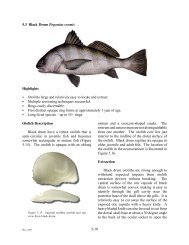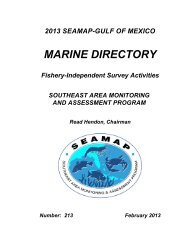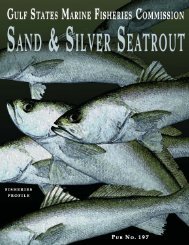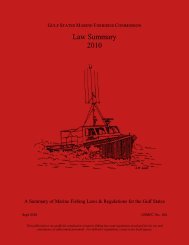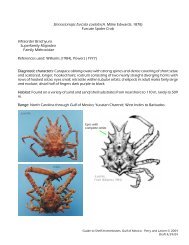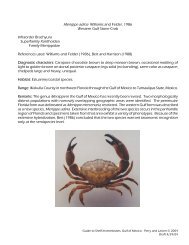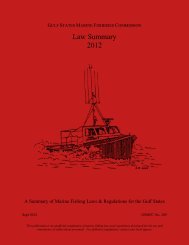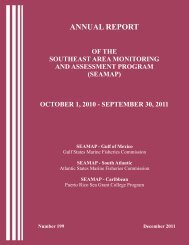Guidelines for Marine Artificial Reef Materials, Second Edition
Guidelines for Marine Artificial Reef Materials, Second Edition
Guidelines for Marine Artificial Reef Materials, Second Edition
You also want an ePaper? Increase the reach of your titles
YUMPU automatically turns print PDFs into web optimized ePapers that Google loves.
• On older government vessels, treatment of contaminants such as asbestos, and PCBs, and<br />
other materials that are considered hazardous wastes under other scenarios, as of spring 2003<br />
have not been aggressively addressed by the EPA in any well-publicized, <strong>for</strong>mal policy<br />
statement or guidelines.<br />
• Procurement of large government-owned vessels through bureaucratic channels (MARAD<br />
or federal surplus property) may take years from initial paperwork application and fund<br />
raising to final deployment, exceeding the time frame in which some funding may be<br />
available and thereby hampering reef construction planning ef<strong>for</strong>ts.<br />
• Vessels with high vertical profile and maximum clearance requirements may end up being<br />
placed so far offshore of coasts with shallow seabed gradients that only a limited segment<br />
of the private recreational fishing community can reach these wrecks.<br />
Considerations<br />
• Several Gulf Coast states and Florida coastal counties have demonstrated that it is possible<br />
to have a viable artificial reef program without vessels. It is important <strong>for</strong> managers to<br />
assess their objectives when securing a vessel, since cleaning and towing costs, especially<br />
when interstate transport is involved, can be prohibitive.<br />
• With the rapid increase in recreational sport diving activities in some areas, ship deployment<br />
in certain areas may have greater value to the diving industry than to the recreational hookand-line<br />
fishery. Vessels deployed in shallow water (60 to 100 feet) are especially attractive<br />
to recreational SCUBA divers. If the funding source is fishing license revenues, and the site<br />
is dominated by divers, this issue should be considered.<br />
• If the intent of developing an artificial reef is to provide recreational fishing opportunities<br />
with some level of fishing success, while at the same time avoiding user conflict, the<br />
combined effect of spear fishing and hook-and-line harvest and liability associated with<br />
diver accidents during wreck diving, may lead to a recommendation to sink vessels at greater<br />
depths (150 to 350 feet).<br />
• Consider using only those steel hulled vessels which are designed <strong>for</strong> operating in heavy sea<br />
conditions, such as ocean going tugs, oil rig re-supply vessels, trawlers, and small freighters,<br />
which are all structurally sound The focus should be on structural and habitat complexity<br />
of vessels, rather than strictly vertical height or sheer overall length.<br />
• Some contractors or other organizations tasked with cleaning vessels, or their hired laborers<br />
and volunteers have historically not always followed proper hazardous materials and other<br />
waste handling and disposal, and/or general OSHA safety protocols due to lack of expertise<br />
or training, inadequate facilities ,equipment and manpower, desire to reduce project time and<br />
expenses, or insufficient guidance or over sight provided by the contract or project manager,<br />
and focus on removal of salvageable material to the detriment of meeting other cleaning and<br />
preparation objectives (Kurtis Gregg, personal communication; Jon Dodrill, personal<br />
-37-




